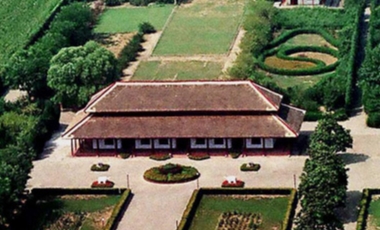Yinxu, also known as Yin Ruins, the ancient capital of the late Shang Dynasty (1300-1046 BC), is located on both banks of the Huan River in the northwestern suburbs of Anyang. It is the first ancient capital site in Chinese to be documented in historical records and confirmed through archaeological excavation.
As the birthplace of oracle bone inscriptions and the cradle of Chinese archaeology, Yinxu has pushed the timeline of China's recorded history back by nearly a millennium. The site has yielded a wealth of precious artifacts, including oracle bones, bronze ware, and jade objects, showcasing the brilliance of late Shang civilization and providing invaluable resources for studying this pivotal era.
Beyond its historical significance, Yinxu offers captivating nighttime experiences. Visitors can take a boat ride along the Huan River to admire its illuminated scenery and enjoy the immersive performance, which brings the splendor of the Shang Dynasty to life.
In 2006, Yinxu was inscribed on the UNESCO World Heritage List. Its value lies in its irrefutable evidence of the Shang Dynasty's existence and its role as a cornerstone for exploring the origins of Chinese civilization.
Opening Hours: 08:00-17:30
Visiting Route: Yinxu Museum → Palace and Temple Complex → Yinxu Royal Tombs
Official phone number:
Yinxu Museum: 0372-5993308
Yinxu Royal Tombs: 0372-3161022
Must-see Highlights
Yinxu Royal Tombs
The Yinxu Royal Tombs served as the burial and ceremonial grounds for royal family members of the Shang Dynasty. It is where the famous Simuwu Ding (a massive bronze cauldron) was unearthed. The site includes 13 royal tombs, over 2,000 burial pits and sacrificial pits, yielding exquisite bronze, jade, and pottery artifacts. Among them, the M1001 tomb, believed to belong to King Wu Ding, is one of the earliest and most significant discoveries.
Palace and Temple Complex
The Palace and Temple Complex is the heart of Yinxu, featuring 53 excavated foundation sites divided into three groups (A, B, and C). Group A structures are thought to be the royal living quarters, while Group B represents ancestral temples. This area showcases the architectural artistry and urban planning of the Shang Dynasty.
Yinxu Museum
The Yinxu Museum is a key venue for displaying the archaeological achievements of Yinxu. It houses a vast collection of precious artifacts, including national treasures like the Simuwu Ding. Through artifacts, images, and multimedia exhibits, the museum vividly brings to life the 3,000-year-old Shang civilization.
YH127 Oracle Bone Pit
The YH127 Oracle Bone Pit is one of Yinxu's most significant discoveries, containing over 17,000 inscribed oracle bones. These inscriptions cover topics such as rituals, agriculture, and astronomy, forming the earliest known "archives" in Chinese history.
Chariot and Horse Pits
The Chariot and Horse Pits at Yinxu are the earliest physical evidence of chariots discovered in China. They reveal the advanced chariot technology and the brutal practice of human and animal sacrifice during the Shang Dynasty, reflecting both the sophistication and harsh realities of the era.


Things to Do
Immersive Archaeological Experience
At the Palace and Temple Complex, visitors can join the "Yinxu Adventure" activity, dressing up in period costumes for a fully immersive experience. The site features interactive game stations where participants can decode oracle bone scripts, simulate archaeological digs, and earn shell coins to redeem prizes.
Oracle Bone Script Learning Program
The Archaeological Science Experience Hall in Yinxu offers family-friendly oracle bone script workshops. Visitors can try their hand at carving ancient characters and learn about Shang Dynasty culture, discovering the charm of China's earliest writing system.
Live-Action Performance
"The Grand Capital of Shang" is a spectacular immersive show featuring light displays, drone performances, and boat rides. It vividly recreates the grandeur of the Shang Dynasty's golden age.
Intangible Heritage Experiences
Yinxu Museum offers a range of creative cultural products and hands-on activities, such as oracle bone script-inspired coffee art and DIY craft workshops. These experiences blend traditional culture with modern creativity, providing a unique way to connect with history.
Best Time to Visit Yinxu
The best time to visit Yinxu is during spring and autumn.
Spring (March to May) brings warm and pleasant weather, with flowers gradually blooming across the site. The cherry blossom season, particularly in April and May, offers especially enchanting scenery.
Autumn (September to November) is marked by cool temperatures, clear blue skies, and golden-hued foliage, making it an ideal season to admire the beauty of Yinxu.
While summer (June to August) can be hot, the lush greenery provides a refreshing backdrop for exploring the site's rich historical and cultural heritage.
In winter (December to February), the cold weather transforms Yinxu into a serene and mystical landscape, especially after a snowfall, offering a unique and tranquil experience.
Transportation Guide
By Air
Anyang Airport offers direct flights to major cities such as Beijing, Shanghai, and Guangzhou. The airport is conveniently located near the city center, making transportation quick and easy.By High-Speed Rail / Train
Anyang is a key railway hub, with the Beijing-Guangzhou High-Speed Railway and the Beijing-Guangzhou Railway passing through the city. Visitors can take a high-speed train to Anyang East Station or a regular train to Anyang Railway Station.By Long-Distance Bus
Anyang has Anyang Bus Station and Linzhou Bus Station. Intercity buses from cities such as Zhengzhou and Xinxiang provide direct access to Anyang.
Travel Tips
Yinxu is expansive and involves a lot of outdoor walking, so wear comfortable shoes suitable for long periods of walking.
During summer visits, bring sunscreen, a hat, or rain gear to prepare for changing weather conditions.
The Yinxu Museum features rich artifact displays and interactive multimedia exhibits. Allocate enough time to fully explore and appreciate the depth of Shang Dynasty culture.
Enhance your trip by visiting nearby sites such as the National Museum of Chinese Writing and Youli City, both located close to Yinxu.
Note
As a UNESCO World Heritage Site, Yinxu requires a quiet and respectful atmosphere. Please avoid touching artifacts and follow all site regulations to help preserve this cultural treasure.
Some areas include archaeological ruins and ancient structures. Watch your step and avoid entering restricted zones to ensure a safe and enjoyable visit.




































